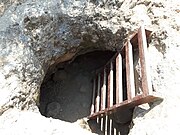Giv'at Ha'yekavim
This article has multiple issues. Please help improve it or discuss these issues on the talk page. (Learn how and when to remove these messages)
|

Givat Hayekavim is an archaeological site in the West Bank, near the Israeli outpost of Harasha, in Gush Talmonim, with remains of a Jewish settlement from the Iron Age and the Second Temple period with four oil presses and a restored wine cellar from the days of the First Temple period.[1]
Archeological findings
[edit]In the site were discovered preserved streets, house walls and an underground system of wine cellars that includes about 30 rock-cut bell cellars, known in the study as "Gibeon wine cellars",[1][2] because this type of wine cellars were first discovered and defined by James B. Pritchard in 1956 in the excavations of al-Jib, which is identified with the biblical Gibeon. They were used as wine cellars to store jugs of wine and olive oil in the days of the First Temple period.[3][4]
However, during the Second Temple period, its cellars were used as warehouses and columbarium. During the Bar-Kokhba revolt, the cellars were used as an hiding complex from the Romans, their openings were sealed with stones and they were connected by tunnels. The site is near Horesh Yaron and Sheikh Issa. It is now called "Givat Ha'yekavim" inspired by the words of Rashi.
Gallery
[edit]References
[edit]- ^ a b Pritchard, James B. (September 1959). "The Wine Industry at Gibeon". Expedition Magazine. Retrieved 2024-04-11.
- ^ "'Atiqot - Publications of the Israel Antiquities Authority". atiqot.org.il. Retrieved 2024-05-08.
- ^ "רביב, דביר, 1983- מחבר; זיסו, בועז, 1966- מנחה תיזה;אוניברסיטת בר אילן. המחלקה ללימודי ארץ ישראל וארכיאולוגיה.;אוניברסיטת בר אילן מוסד מעניק תואר". biu.primo.exlibrisgroup.com. Retrieved 2024-04-11.
- ^ "'Atiqot - Publications of the Israel Antiquities Authority". atiqot.org.il. Retrieved 2024-05-08.


